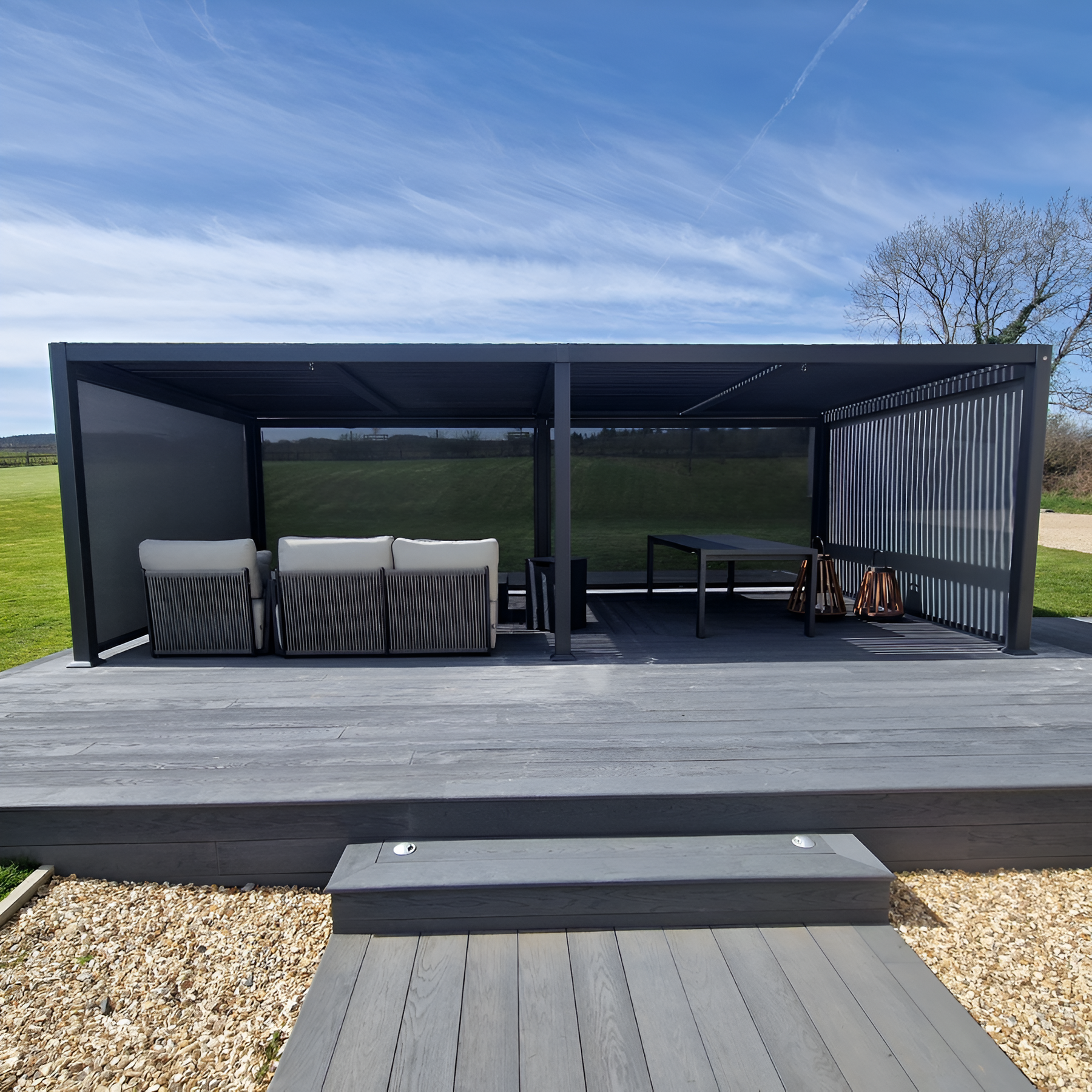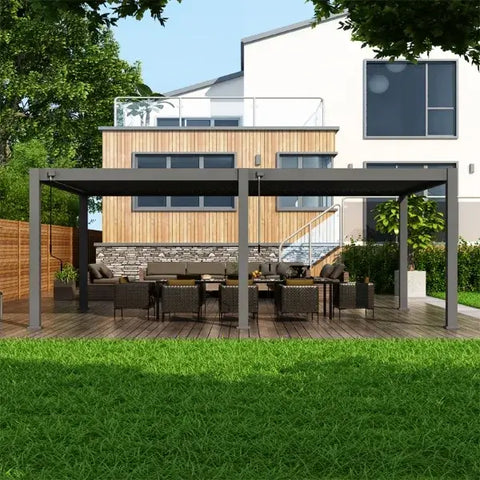
What on earth is the difference between a Pergoda and a Pergola?
Pergoda or Pergola?
Welcome to the wonderful world of pergolas! If you're unfamiliar with this term, don't worry. You're not alone.
Many people confuse pergolas with pagodas or have no idea what they are at all. But fear not, because we're here to shed some light (shading structure pun), on these garden structures.
To begin, let's clarify the difference between a pergola and a pagoda. While they may sound similar, they are actually quite distinct from one another.
A pagoda is traditionally an Asian religious structure with multiple tiers and upturned eaves, often found in Buddhist temples and gardens. On the other hand, a pergola is an outdoor garden feature that consists of vertical posts supporting a louvered, grid, hard top, or lattice roof.
So what's the point of having a pergola in your garden? Well, there are several reasons why people choose to add this charming addition to their outdoor spaces.
In the UK, where unpredictable weather can be the norm, having a pergola provides some shelter from rain showers while still allowing you to enjoy the fresh air and natural surroundings. But let's say you live in an area where rainy days aren't much of a concern – what's the point then?
Well, alongside being visually appealing and adding an elegant touch to your garden or patio area, pergolas also serve as perfect structures for climbing plants such as ivy or grapevines. These plants can create a beautiful natural canopy overhead while providing shade during hot summer days.
When it comes to materials for building your own pergola, you have options like wooden pergolas or ones made from aluminium. Wooden pergolas offer that rustic charm and blend seamlessly into nature but require regular maintenance to prevent rotting or warping over time.
Aluminium pergolas, on the other hand, are more durable and require less upkeep but may lack that organic feel.
It's no secret that aluminium pergolas are our favourites, so if enjoying your garden all year round without worrying about wind or rain sounds good, then check out our range of Aluminium pergolas.

Pagoda vs Pergola
When it comes to outdoor structures, the terms pagoda and pergola are often used interchangeably, but they actually serve different purposes. Let's delve into the world of pagodas and pergolas and understand the nuances between them.
A pagoda is a traditional Asian architectural structure commonly found in countries like China, Japan, and Korea. It typically consists of multiple tiers with upward-curving roofs that have a distinct curved shape.
Pagodas are often made of wood or stone and serve as religious or ceremonial buildings. They are known for their intricate detailing, vibrant colours, and historical significance.
Pagodas are enchanting structures that exude a sense of tranquillity and serenity. On the other hand, a pergola is an open-air structure that provides shade and defines an outdoor space.
It usually consists of vertical posts supporting horizontal crossbeams and a roof (best when louvered). Pergolas can be made from various materials such as wood, aluminium or vinyl, each offering its own unique aesthetic appeal.
Unlike pagodas which are steep-roofed structures with multiple tiers, pergolas have a flat or gently sloping roofline. They can be adorned with climbing plants like vines or flowers to create a natural canopy effect.
Generally, when our customers are looking for a pagoda, they are more often actually looking for a pergola or gazebo.

Pagoda vs Gazebo
When it comes to outdoor structures, pagodas and gazebos often get confused with each other. While they share some similarities, there are distinct differences that set them apart. Let's delve into the comparisons between pagodas and gazebos.
As we've established, a pagoda is an architectural structure that originated in East Asia, particularly in countries like China, Japan, and Korea. It features multiple tiers of roofs that gradually get smaller as they ascend.
These roofs are often curved or sloping with upturned eaves, giving the pagoda its iconic and elegant look. Pagodas have historical and cultural significance in Asian countries, often serving as religious or ceremonial sites.
In contrast, gazebos have a more Western origin and are typically freestanding structures with an open design. They usually have a single roof supported by columns or pillars, offering a shaded area for relaxation or social gatherings.
Gazebos are more commonly found in gardens or parks as a place for people to gather, enjoy nature, or host events like weddings or outdoor parties. The purpose of a pagoda is deeply rooted in spirituality and symbolism whereas gazebos serve more practical purposes for leisure activities.
Wooden Gazebo

What is the point of a pergola?
We love this question! Always makes us chuckle :)
Well, it really depends on what type of pergola you're referring to.
An Aluminium Pergola:
These have a huge practical purpose. They allow you to create a complete weatherproof space, protecting you and your guests from rain, wind and sun, all at the adjustment of the louvered roof and side blinds. An aluminium pergola creates the ability for you to cook, lounge and dine in your garden, whatever the weather.

A Wooden Pergola:
There is much less of a "point" to wooden / vinyl pergolas. They are aesthetic really. They won't change the way you live in your outdoor space, but they will add rustic charm and zoning. They are great for growing beautiful plants and flowers up and over.

What is the point of a pergola without roof?
Controversial! There isn't one really! No practical purpose anyway. When a pergola has a roof, ideally an adjustable louvered one, it offers protection from the rain and shade in the heat.
A pergola with no roof is purely aesthetic really, generally for zoning and/or growing plants and flowers up.

How to pronounce Pergola
It's quite straightforward - simply say "per-go-lah" with the stress on the second syllable. Although lots of people say "pergo-lah" and that's ok, you know "tom-ay-toe" / "tom-ah-toe" - just kidding, it's "tom-ah-toe".

Summary - What is a Pagoda
A pagoda is a beautiful and distinct architectural structure that originated in East Asia, most notably in countries like China, Japan, and Korea. It is often characterized by its multi-tiered roofs with curved eaves, intricate woodwork or stone carvings, and its serene and spiritual ambiance.
It is commonly found near Buddhist temples or monasteries and is used as a place for meditation, prayer, or religious rituals. Pagodas are also known for their symbolism; each tier represents a different level of enlightenment or spiritual attainment.
The architecture of the pagoda reflects the traditional Asian design principles that emphasize harmony with nature and the surrounding environment. Unlike pagodas, pergolas have a more versatile purpose.
Other content you'll love:
Do you need planning permission for a pergola?
How long do aluminium pergolas last?


